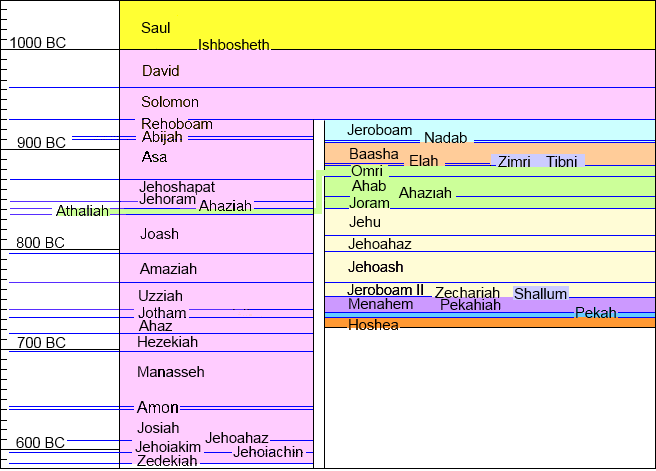REL 433 - Biblical Archaeology
Course Notes
Module 11 - Iron Age IIB
The Divided Monarchy, 925-587 BC
![]() Chronology of the Kings of Israel and Judah
Chronology of the Kings of Israel and Judah
The absolute chronology of the kings of Israel and Judah is a matter of continuing discord among Bible scholars. The problem is that different cultures have used different methods of recording the length of a king's reign, and have used different calendars through the centuries, so it is no longer possible to assign absolute dates to events in the distant past.
The Israelites used a lunar calendar. When recording the length of a king's reign, they recorded the year in which he died as a full year. Some of the kings appointed one of their sons as a co-ruler towards the end of their life (eg. David and Solomon, I Kings 1:12-34) In the Northern Kingdom of Israel there was sometimes a period of civil war between reigns, with more than one person claiming to be King.
I usually use the chronology given by John Bright in his "A History of Israel", which may differ slightly from that used by our textbook.

The chart covers both Iron Age IIA (the United Monarchy), Iron Age IIB (the Divided Monarchy), and Iron Age IIC (Judah alone). The kings of the Northern Kingdom of Israel are shown to the right, the kings of Judah, and of the United Monarchy are to the left.
Different background colors indicate different dynasties.
![]() The Divided Monarchy, 925-587 BC
The Divided Monarchy, 925-587 BC
The division of the kingdom after the death of King Solomon was caused mainly by the widespread discontent with high taxes and forced labor to support Solomon's building projects (I Kings 12:1-17)
The Northern Kingdom, retaining the name of "Israel" tended to be politically unstable, with several changes of dynasty. The capital city changed several times : Jeroboam chose Shechem for his palace, but Dan and Bethel as centers for worship (I Kings 12:25-29).
Baasha killed Jeroboam's son Nadab, and reigned from Tirzah (I Kings (I Kings 15:25-28).
Zimri killed Baasha's son Elah, but only reigned for seven days before the people rose in revolt, and Zimri committed suicide by burning his palace and dying in the fire (I Kings 16:8-18). Civil war ensued, between Tibni and Omri, which Omri eventually won (I Kings 16:21-22).
Omri built the city of Samaria as his capital, and founded a strong dynasty; his daughter Athaliah married Jehoram, king of Judah (II Kings 8:26), and his son Ahab married Jezebel, daughter of the Phoenician king of Sidon (I Kings 16:30-31).
The Omrid dynasty came to an end when Jehu was anointed as King of Israel by a messenger sent from the prophet Elisha (II Kings 9:1-13). In the ensuing war, both King Joram of Israel and King Ahaziah of Judah were killed, and also Joram's mother, Queen Jezebel. (II Kings 9:24, 27, 30-36).
Jehu's dynasty came to an end with the conspiracy of Shallum, but Shallum only managed to hold the throne for one month before he was killed by Menahem. (II Kings 15:8-10, 13-14).
The Kingdom of Israel changed hands again when Menahem's son Pekahiah was assassinated by Pekah (II Kings 15:23-25), and again when Pekah was killed by Hoshea (II Kings 15:30). However, by this time the Assyrians had started to take control of the region, and Hoshea's reign ended with the Fall of Samaria and the deportation of the northern tribes in 722 BC (II Kings 17:1-6).
![]() Back to this week's Assignment
Back to this week's Assignment
Copyright © 1999 Shirley J. Rollinson, all Rights Reserved